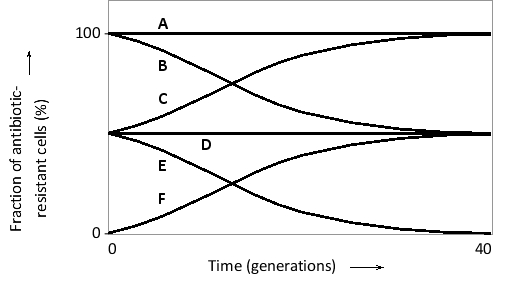Two haploid budding yeast cells are allowed to mate. One of them carries a mutation in its mitochondrial DNA that makes the yeast cell resistant to an antifungal drug. If the resulting diploid zygote is allowed to propagate (in the absence of the drug), how do you predict that the fraction of drug-resistant cells will change over time in the population? Choose the best curve (A to F) from the following graph. Note that the "population" is only composed of one cell at the beginning of the experiment. The curves are smoothened to cancel stochastic fluctuations that happen at such low population sizes. 
Correct Answer:
Verified
View Answer
Unlock this answer now
Get Access to more Verified Answers free of charge
Q26: The water-splitting step in photosynthesis …
A) occurs
Q27: The electrons used in carbon fixation by
Q28: What is the main reason why atmospheric
Q29: Indicate true (T) and false (F) statements
Q30: The cytochrome b₆-f complex that transfers electrons
Q32: When the special pair in a photosystem
Q33: Indicate true (T) and false (F) statements
Q34: In the following simplified diagram of the
Q35: Indicate whether each of the following descriptions
Q36: Order the following metabolic innovations to reflect
Unlock this Answer For Free Now!
View this answer and more for free by performing one of the following actions

Scan the QR code to install the App and get 2 free unlocks

Unlock quizzes for free by uploading documents